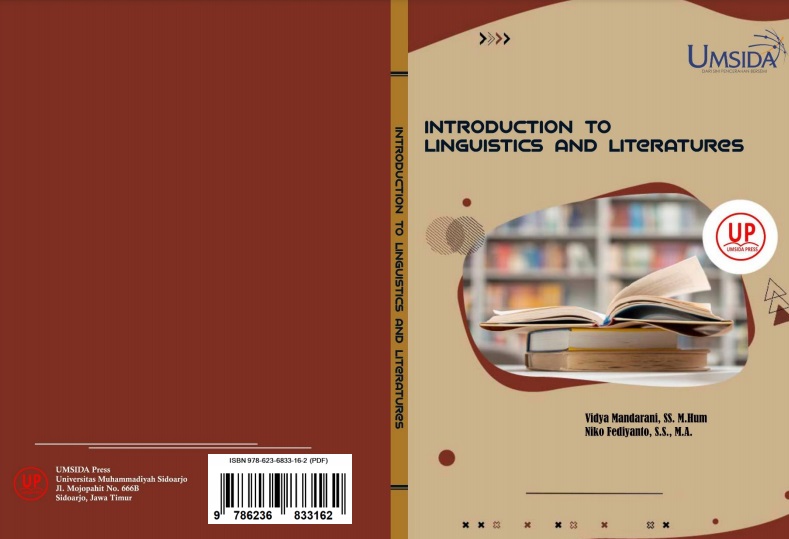Introduction to Coursebook Linguistics & Literature
DOI:
https://doi.org/10.21070/2020/978-623-6833-16-2Keywords:
Linguistics, Literature, CoursebookAbstract
All praise and gratitude be offered by us upon Allah swt. The Most Glorified and Most High, due to His graces and bounties that this coursebook of Introduction to Linguistics & Literature was able to get properly completed without any significant impediments. May shalawat and salaam will always be conveyed by us, upon our revered prophet Muhammad (pbuh). The authors would love to deliver the thankfulness upon: 1. Dr. Akhtim Wahyuni, M.Ag., the Dean of Psychology and Education Science Faculty, who gave her guidance and motivations towards the authors in accomplishing this book.2. Yuli Astutik, M.Pd., the Chairwoman of English Education Study Program, who provided her support in drafting this book. 3. Fellow supporting lecturers of introduction to Linguistics and Literature course, in English Education Study Program, who have shared their experiences in delivering the course. Suggestion and critics are genuinely expected in attempt to create a better coursebook of Introduction to Linguistics and Literature, which is in accord with the stipulated mandate.
Downloads
References
Abrams, M. H., & Norton, D. S. (1957). A Glossary of Literary Terms. NY: Rinehart.
Anz. (2016). Homonim dan Polisemi. Retrieved April 29, 2020, from Badan Bahasa Kemendikbud RI:http://badanbahasa.kemdikbud.go.id/lamanbahasa/node/1928
____. (2015). What are Micro-linguistics and Macro-linguistics? Retrieved April 21, 2020, from eNotes Editorial:http://www.enotes.com/homework-help/what-micro-linguistics-macro-linguistics-518599
____. (2020). Sinonim. Retrieved April 29, 2020, from Badan Bahasa Kemendikbud RI:http://badanbahasa.kemdikbud.go.id/lamanbahasa/petunjuk_praktis/609
Bauer, L. (1983). English Word Formation. Cambridge: Cambridge University Press.
Beard, A. (2001). Texts and Contexts: Introducing Literature and Language Study. London: Psychology Press.
Chomsky, N. (2006). Language and Mind. UK: Cambridge University Press.
Crystal, D. (1993). The Structure of Language. In D. Crystal, & R. Beard (Ed.), Teaching Literacy: Balancing Perspectives (pp. 15-21). London: Hodder and Stoughton.
Culler, J. (1997). Literary Theory: A Very Short Introduction (2nd ed.).Oxford: Oxford University Press.
Dollimore, J., & Sinfield, A. (Eds.). (1994). Political Shakespeare: Essays in Cultural Materialism (2nd ed.). Manchester: ManchesterUniversity Press.
Eagleton, T. (1996). Literary Theory: An Introduction. Victoria: Blackwell Publishing.
Forster, E. M. (1956). Aspects of The Novel. NY: Mariner Press.
Frawley, W. (1992). Linguistic Semantics. New Jersey: Lawrence Erlbaum Associates Inc.
Fromkin, V., & Rodman, R. (2003). An Introduction to Language (4th ed.).Fort Worth: Harcourt Brace College Pub.
Griffiths, P. (2006). An Introduction to English Semantics and Pragmatics.UK: Edinburgh University Press Ltd.
Horn, L., & Ward, G. (2006). The Handbook of Pragmatics. USA: BlackwellPublishing Ltd.
Hurford, J., Heasley, B., & Smith, M. (2007). Semantics: A Coursebook (2nded.). UK: Cambridge University Press.
Introduction: Theory and Theories of Morphology. (2019). In J. Audring, &F. Masini (Eds.), The Oxford Handbook of Morphological Theory.Oxford University Press.
Jackendoff, R. (2020). How Did Language Begin? New York: Linguistic Society of America. Retrieved from Linguistic Society of America.
Kenney, W. P. (1966). How To Analyze Fiction. NY: Monarch Press.
Kracht, M. (2008). Phonetics and Phonology I-IV. In M. Kracht, Introduction to Linguistics (pp. 12-66). Los Angeles: University of California.
Lass, R. (1984). Phonology: An Introduction to Basic Concepts. Cambridge: Cambridge University Press.
Mambrol, N. (2016, March 18). Cleanth Brooks’ Concept of Language of Paradox. Retrieved from Literary Theory and Critism: https://literariness.org/2016/03/18/cleanth-brooks-concept-of-language-of-paradox/
Nemerov, H. (2019, October 11). Poetry. Retrieved July 7, 2020, fromEncyclopedia Britannica: https://www.britannica.com/art/poetry
Norvig, P. (2007). Inference in Text Understanding. The 2007 AAAI Spring Symposium. USA.
Raja, V. L. (2014). Word Formation: Morphological Analysis. Journal of Language and Literature, 14(1), 81-86. doi:10.24071/joll.v14i1
Roach, P. (2009). English Phonetics and Phonology: A Practical Course (4th ed.). UK: Cambridge University Press.
Saeed, J. I. (2000). Semantics. Oxford: Blackwell Publishers Ltd.
Schmitz, A. (2012). Chapter 13: The Importance of Language. Retrieved April 21, 2020, from Saylor Academy:
https://saylordotorg.github.io/text_stand-up-speak-out-the- practice-and-ethics-of-public-speaking/s16-the-importance-of- language.html
Stabler, E. (2010). Linguistics 20. Retrieved July 5, 2020, from http://wintermute.linguistics.ucla.edu/Lx20/
Tallerman, M., & Gibson, K. (2012). The Oxford Handbook of Language Evolution. New York: Oxford University Press.
Teufel, S. (n.d.). L114 Lexical Semantics: Figurative Language. UK, University of Cambridge.
Todd, L. (1987). An Introduction to Linguistics. Beirut: Longman York Press.
Ullman, S. (1972). Semantics: An Introduction to the Science of Meaning. Oxford: Basil Blackwell.
Wallis, C. (2020). Inferences and Human Inference Abilities. Retrieved from California State University: https://web.csulb.edu/~cwallis/170/text/Inferences.pdf
Wardhaugh, R. (1987). Introduction to Linguistics (2nd ed.). New York:McGraw Hill, Inc.
Wellek, R., & Warren, A. (1956). Theory of Literature (3rd ed.). San Diego: Harcourt.
Yule, G. (1997). Pragmatics. UK: Oxford University Press.
Zsiga, E. (2006). An Introduction to Language and Linguistics. (R. Fasold, & J. Connor-Linton, Eds.) UK: Cambridge University Press.

Downloads
Published
How to Cite
License
Authors retain copyright and grant the Umsida Press right of first publication with the work simultaneously licensed under a Creative Commons Attribution 4.0 International License that allows others to share the work with an acknowledgement of the work's authorship and initial publication in this platform.

